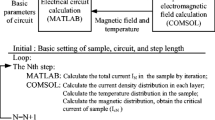Abstract
Coated conductors are very promising for the design of a novel and efficient superconducting fault-current limiter (SFCL). The thermal and electrical behaviors of this type of SFCL in the presence of over-critical currents need to be investigated in detail to master its performance in a power grid. In this paper, an Electrothermal Model of a Coated Conductor (ETMCC), not simulated in the literature, is implemented and introduced in the library of MATLAB software. An algorithm to solve the differential equations characterizing the superconducting material is developed using the Runge-Kutta method. In this context the ETMCC under over-critical current is performed. Different dimensions and substrate configurations of the sandwich layers are considered. In order to improve the high-temperature superconductor (HTS)-FCL design, the influence of the substrate and shunted layers (using different materials) on the thermal stability is investigated. The simulation results are generalized, thus allowing us to determine the current threshold to achieve thermal stability of the HTS-FCL at any point of the coated conductor.















Similar content being viewed by others

References
Giese, R.F., et al.: Assessment study of superconducting fault current limiters operation at 77 K. IEEE Trans. Power Deliv. 8(3), 1138–1147 (1993)
Smith, R.K., et al.: Solid state distribution current limiter and circuit breaker application requirements and control strategies. IEEE Trans. Power Deliv. 8(3), 1155–1164 (1993)
Thuries, E., et al.: Toward the superconducting fault current limiter. IEEE Trans. Power Deliv. 6, 801–808 (1991)
Chen, M., et al.: Fabrication and characterization of superconducting rings for fault current limiter application. IEEE Trans. Appl. Supercond. 282–287, 2639–2642 (1997)
Noe, M., Oswald, B.R.: Technical and economical benefits of superconducting fault current limiters in power systems. IEEE Trans. Appl. Supercond. 9(2), 1347–1350 (1999)
Paul, W., et al.: Fault current limiter based on high temperature superconductor—different concepts, test results, applications, simulations. Physica C 354, 27–33 (2001)
Ahn, M.C., Bae, D.K., Yang, S.E., Park, D.K., Ko, T.K., Lee, C., Seok, B.Y., Chang, H.M.: Manufacture and test of small-scale superconducting fault current limiter by using the bifilar winding of coated conductor. IEEE Trans. Appl. Supercond. 16(2), 646–649 (2006)
Prusseit, W., Sigl, G., Nemetschek, R., Hoffmann, C., Handke, J., Kinder, H.: Commercial coated conductor for fabrication based on inclinated substrate deposition. Presented at the ASC 2004, Jacksonville, FL, 4–8 Oct. 2004, Paper 1MR07
Park, D.K., Yang, S.E., Kim, Y.J., Chang, K.S., Ko, T.K.: Experimental and numerical analysis of high resistive coated conductor for conceptual design of fault current limiter. Cryogenics 49, 249–253 (2009). doi:10.1016/j.cryogenics.2008.09.006
Roy, F., Pérez, S., Therasse, M., Dutoit, B., Sirois, F., Decroux, M., Antognazza, L.: Quench propagation in coated conductors for fault current limiters. Physica C 469, 1462–1466 (2009). doi:10.1016/j.physc.2009.05.066
Roy, F., Dutoit, B., Grilli, F., Sirois, F.: Magneto-thermal finite element modeling of 2nd generation HTS for FCL design purposes. J. Phys. Conf. Ser. 97, 012286 (2008). 8th European Conference on Applied Superconductivity (EUCAS 2007). doi:10.1088/1742-6596/97/1/012286
Roy, F., Dutoit, B., Grilli, F., Sirois, F.: Magneto-thermal modeling of second-generation HTS for resistive fault current limiter design purposes. IEEE Trans. Appl. Supercond. 18(1), 1051–8223 (2008)
Nemdili, S., Belkhiat, S.: Modeling and simulation of resistive superconducting fault-current limiters. J. Supercond. Nov. Magn. 25(7), 2351–2356 (2012). doi:10.1007/s10948-012-1685-z
Noudem, J.G., et al.: Study of the superconducting transition at high pulsed current of bulk Bi-2223 sintered and textured by hot forging. Physica C 339–344, 01281 (1997)
Author information
Authors and Affiliations
Corresponding author
Rights and permissions
About this article
Cite this article
Nemdili, S., Belkhiat, S. Electrothermal Modeling of Coated Conductor for a Resistive Superconducting Fault-Current Limiter. J Supercond Nov Magn 26, 2713–2720 (2013). https://doi.org/10.1007/s10948-012-1895-4
Received:
Accepted:
Published:
Issue Date:
DOI: https://doi.org/10.1007/s10948-012-1895-4



